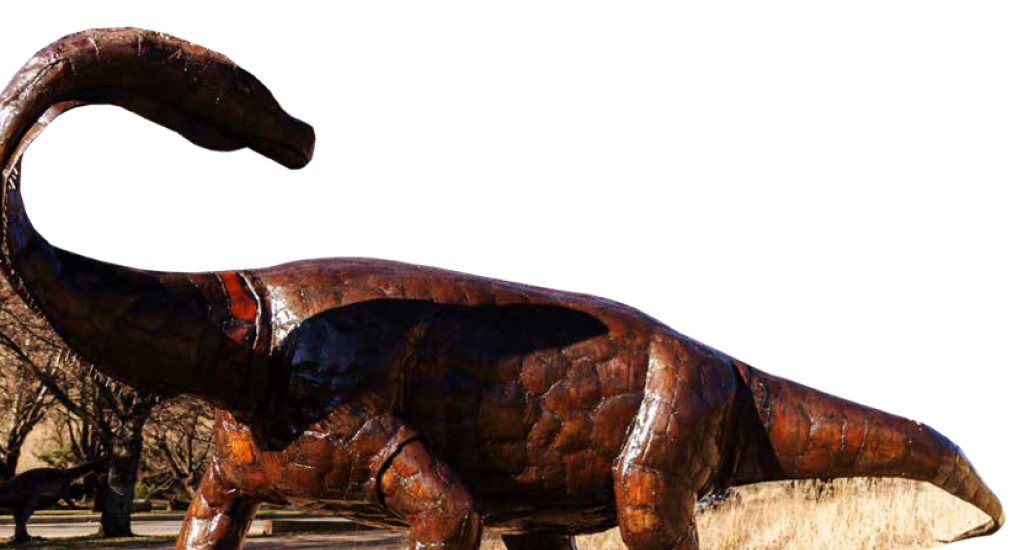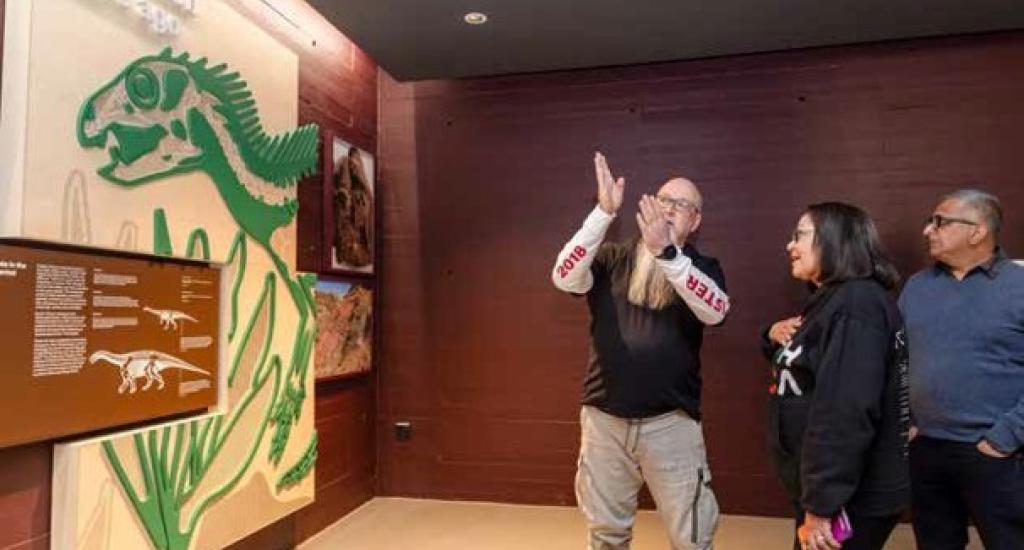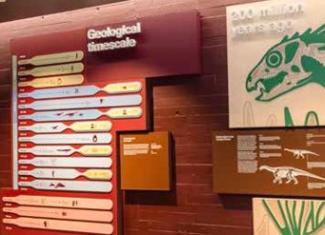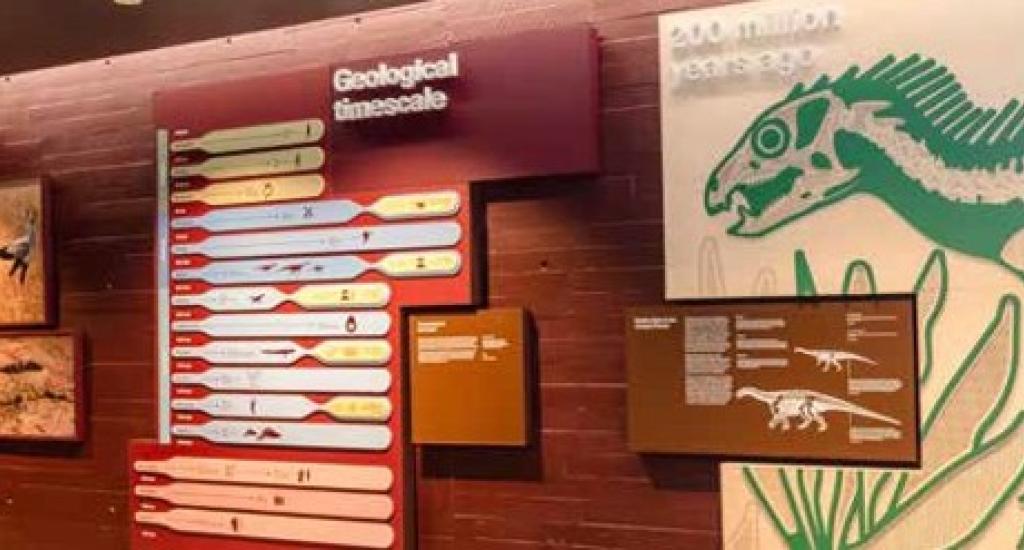Visit Kgodumodumo Dinosaur Interpretation Centre and experience history in action

About 200 million years ago, on the wide-open plains of what is now the Golden Gate Highlands National Park in the Free State, there dwelled a monster, whose every step shook the earth and could be heard for miles around.
Ledumahadi Mafube (meaning “a giant thunderclap at dawn” in Sesotho), a 12-ton, 12-meter-long South African dinosaur first discovered in 1989 by James Kitching in the Free State, is considered the heaviest dinosaur to have roamed the pre-historic Golden Gate Highlands National Park.
Ledumahadi Mafube, is one of the many dinosaurs on display at the Kgodumodumo Dinosaur Interpretation Centre, located within the Golden Gate Highlands National Park. It is the only one in the world, reaching 14 metres long and 3 metres wide at the hips.
The story of the dinosaurs that roamed South Africa, millions of years ago, is a fascinating one. Thanks to the departments of Tourism; and Forestry, Fisheries and the Environment, along with SANParks, this has been brought to life through the recently launched Kgodumodumo Dinosaur Interpretation Centre.
A step back into time
Entering the centre is like taking a step back into time, a time of monsters, myths and legends.
The R120-million centre, funded through the European Union, is a world-class facility that opens a window to the past while speaking powerfully to the present. It offers visitors a journey through time, giving them insights into South Africa's rich fossil record, while they learn about Earth's evolutionary history. The centre appeals to the child in all of us.
This new attraction also positions the Golden Gate Highlands National Park to become an internationally recognised tourist destination. It is the only space in the world to exclusively celebrate and experience Southern African dinosaurs that inhabited the planet millions of years ago.
The centre offers something for everyone, from kids on school trips to families having a fun day out. It includes various fossil exhibits, interactive displays, timelines and life-sized dinosaur models, drawing attention to the numerous significant paleontological discoveries made within the park and surrounding areas.
These include marvels such as the world’s oldest fossilised dinosaur embryos belonging to Massospondylus carinatus, a five-metre long herbivore that nested in the Free State 200 million years ago.
The centre is named after a mythical monster called Kgodumodumo (meaning “Great Giant” in Sesotho).
The BaSotho people and their ancestors inhabited and explored this eastern Free State landscape for hundreds of years. Through their deep connection with the land, early BaSotho communities discovered fossil bones and footprints of unknown creatures. They imagined that these bones and footprints belonged to mythical beast, “Kgodumodomo” and created stories about them that still feature in BaSotho mythology today.
Involving local communities
The retelling of these stories are just some of the marvels that will greet guests, who will hear thrilling accounts of “monsters” from local BaSotho people who are an integral part of the centre. The Department of Tourism has trained about 15 tourist guides for this purpose.
As part of the project, 113 people from the local communities were employed during the construction phase.
Hope for beneficiaries
While offering an unparallel view into the past, the centre is also a place of hope for a better tomorrow. It tells the story of the land claimant settlement agreement which includes a beneficiation package that largely consists of eco-tourism opportunities, such as the camping site, horse riding, mountain biking, a 4x4 trail and hiking trails.
The claimant’s beneficiaries receive 5% of each of the game off-takes, whether it is the sale of meat or live game auctions. It also includes share equity of the coffee shop and proposed curio shop sales of any new public-private partnership concession in the park – with a Zipline business expected to be launched soon.
There are many possible spin offs from the centre, including increased demand for accommodation, tour guides, and food offering.
In the mind of time
According to scientists, if you walked in the Golden Gate Highlands National Park 200 million years ago, you would have seen towering conifer trees, ancient relatives of South Africa’s majestic yellow wood trees.
Tiny, mouse like relatives of today’s mammals might have scurried underfoot, and other more badger-like species might have dashed back to their burrows to hide. Jack-Russell sized early crocodiles, not confined to water, might have snapped at you from the undergrowth. Some of the most ancient land-turtles known might have lumbered past, looking much like today’s leopard tortoises. And of course, there would have been dinosaurs.
Tiny plant eaters like Lesothosaurus, running on two legs. Tiny meat-eaters like Megapnosaurus chasing after them. Kudu-sized Massospondylus, perhaps scraping out nesting holes. And the first true giants, like Ledumahadi Mafube towering over all, reaching the size of two full grown African elephants.
Other exhibitions
Those looking to dig deeper can explore dinosaur exhibits, featuring fossils from the University of the Witwatersrand’s fossil archive of the eastern Free State. The exhibition covers fossil formation, the knowledge gained from fossils and the methods used to gather this information. It also explains the geology of the Golden Gate region.
Before walking in the footsteps of “monsters”, guests can grab a beverage at Phoka Coffee – a proudly BaSotho initiative.
Visit this iconic new attraction with your friends and find your joy in the beautiful Free State Province. Let the tour guides take you back into time through the winding landscapes.
videos & photos
What you need to know:
- The centre is accessible by wheelchair.
- Exhibits are complemented by braille panels, ensuring accessibility for visually impaired visitors.
- The centre is family friendly.
NB: Entrance to the Centre is free to the public until 30 September 2025, please bring your ID.






